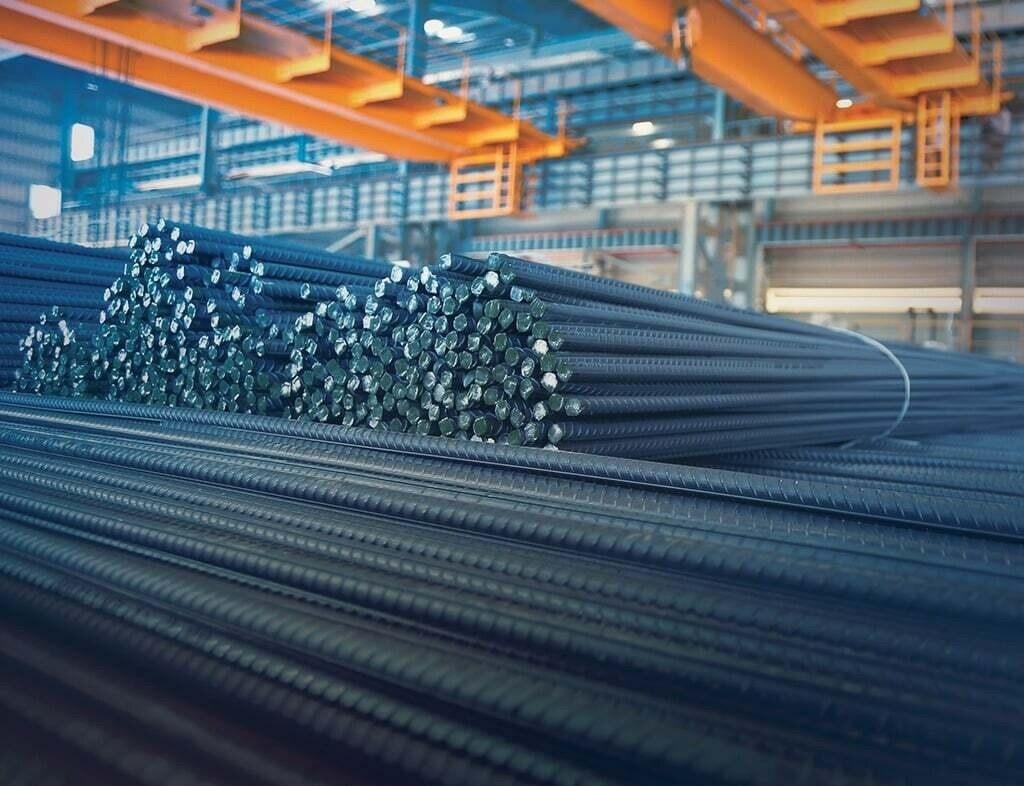REBAR STEEL GR-60
REBAR STEEL GR-60
GR-60 Hot Drawn
Rebar (short for reinforcing bar), collectively known as reinforcing steel and reinforcement steel, is a steel bar or mesh of steel wires used as a tension device in reinforced concrete and reinforced masonry structures to strengthen and hold the concrete in compression, Concrete is strong under compression, but has weak tensile strength.
Rebar significantly increases the tensile strength of the structure.
Rebar surface is often patterned to form a better bond with the concrete. The most common type of rebar is carbon steel, typically consisting of hot-rolled round bars with deformation patterns, Other readily available types include stainless steel, and composite sections made of glass fiber, carbon fiber, or basalt fiber.

These alternate types tend to be more expensive or have lesser mechanical properties and are thus more often used in specialty construction where their physical characteristics fulfill a specific performance requirement that carbon steel does not provide.
In practice, any material with sufficient tensile strength that is materially compatible with concrete could potentially be used to reinforce concrete, for example bamboo might be considered a viable substitution in regions where steel is not available.
Steel and concrete have similar coefficients of thermal expansion, so a concrete structural member reinforced with steel will experience minimal stress as the temperature changes.
Rebars can be identified by marks inscribed on to the surface of one side of rebar as per SASO ASTM 615 M and SASO ASTM 706M standards.
The precise process control adopted at results in clean steel with very low content of undesirable residual elements, higher yield strength, good ductility and better bending properties of the steel bar. The lower carbon equivalent values used in also make them readily wieldable, particularly for the applications requiring low heat input like tack welding.
REINFORCING BARS
Steel strengthens structures and reinforces the foundations of prosperity in the region.
Mechanical Properties of Steel Rebars
| Standard Diameter (mm) | Grade | Nominal Strength MPa (min.) | Yield Strength MPa (min.) | Tensile to Yield Ratio (min.) | Tensile in 200mm (min.) | Elongation (A5) (min.) | Elongation (min.) | Agt % |
| SASO ASTM A615M | 280(40) | 12 | 280 | 420 | N/A | 12 | N/A | N/A |
| 14 – 18 | ||||||||
| 420(60) | 12 – 20 | 420 | 620 | N/A | 9 | N/A | N/A | |
| 25 | 8 | |||||||
| 32 – 40 | 7 | |||||||
| 520(75) | Dec-25 | 520 | 690 | N/A | 7 | N/A | N/A | |
| 32 – 40 | 6 | |||||||
| SASO ASTM A706M | 420(60) | 12 – 20 | 420 – 540 | 550 | 1.25 | 14 | N/A | N/A |
| 25 – 36 | 12 | |||||||
| 40 | 10 | |||||||
| BS 449 | 460B | 12 – 40 | 460 | N/A | 1.08 | N/A | 14 | 5 |
| BS 449 | B500B | 12 – 32 | 500 | N/A | 1.08 | N/A | N/A | 5 |
| GCC Standard GS06 / ISO 6935-2 | B400BR | 12 – 40 | 400 | N/A | 1.08 | N/A | 14 | 5 |
| B400BWR | ||||||||
| B500BR | 12 – 32 | 500 | N/A | 1.08 | N/A | 14 | 5 | |
| B500BWR |
Chemical Composition of Steel Rebars
Standard | Grade | Chemical composition % (maximum) | |||||||
|
| C | Si | Mn | S | P | N | Cu | C.E.V. |
SASO ASTM A615 | 280/420/520 |
|
|
|
| 0.06 |
|
|
|
SASO ASTM A706M | 420(60) | 0.3 |
|
| 0.05 | 0.04 |
|
| 0.55 |
BS 4449 | 460(B) | 0.3 |
|
| 0.05 | 0.05 | 0.01 |
| 0.51 |
BS 4449 | B500B | 0.2 |
|
| 0.05 | 0.05 |
| 1 | 0.5 |
GCC Standard | B400BR / B500BR |
|
|
| 0.06 | 0.06 |
|
|
|
GS06/ ISO 6935-2 | B400BWR / B500BWR | 0.2 | 1 | 2 | 0.05 | 0.05 | 0.01 |
| 0.5 |


NOTES:
- Other elements like,Ni,Cr,Mo,V,Nb,Ti…etc. may be added if required.
- Higher nitrogen contents are permissible if sufficient quantities of nitrogen binding elements are present.
- Product analysis may differ. Standard tolerances will apply.
